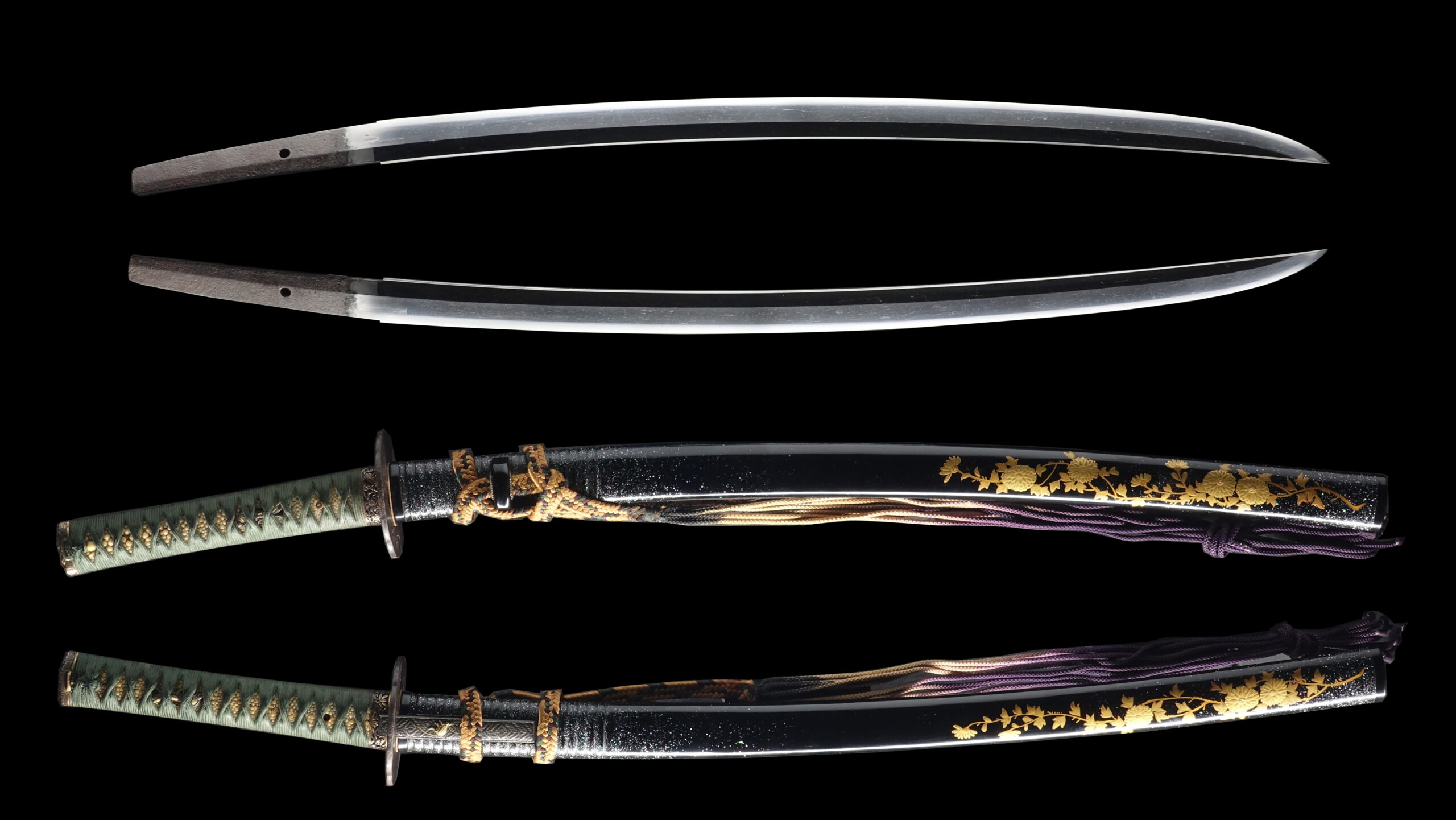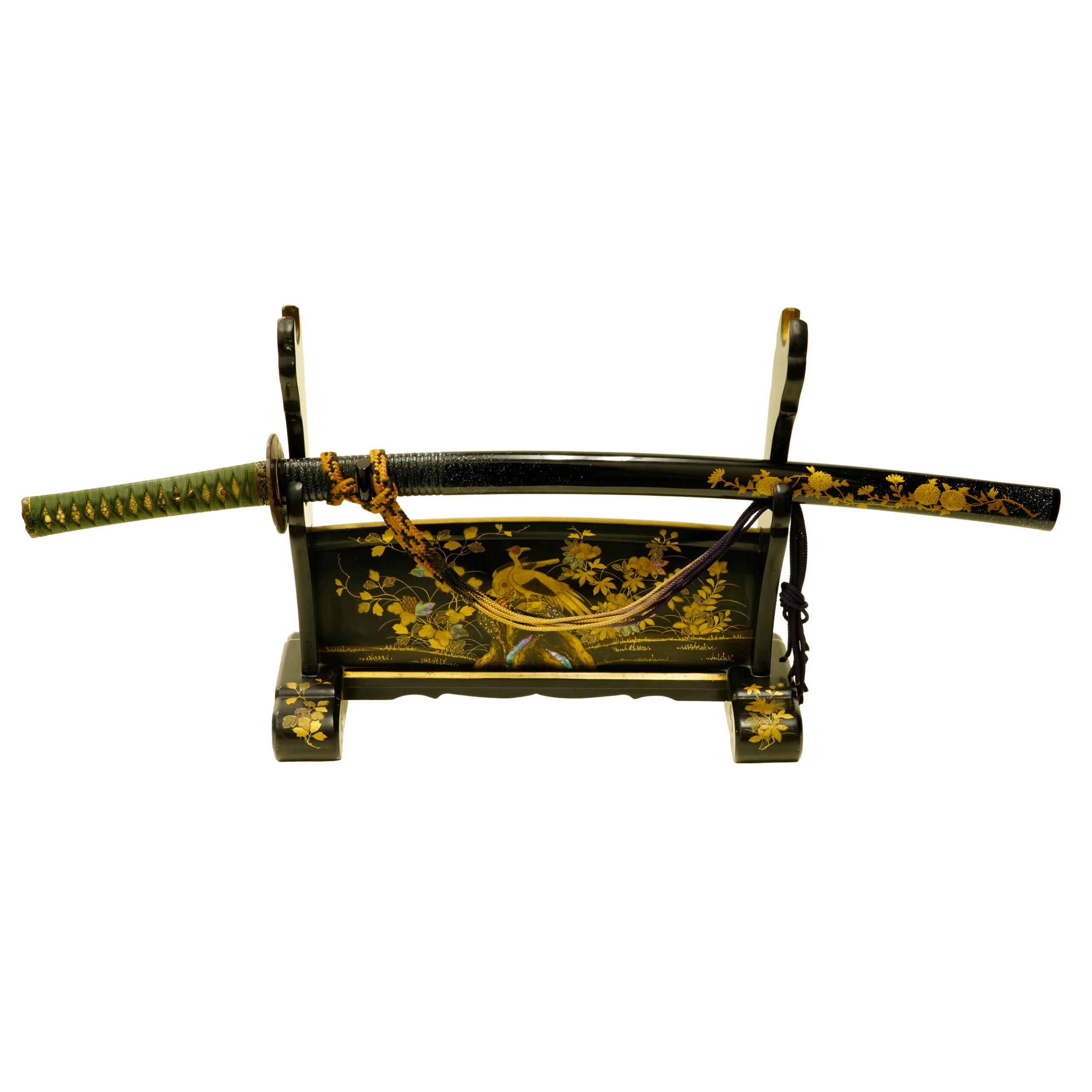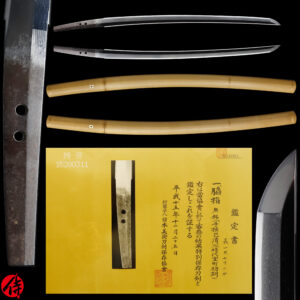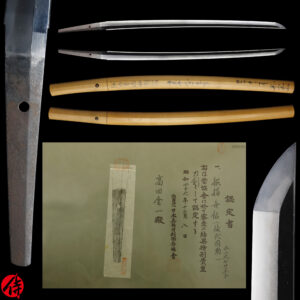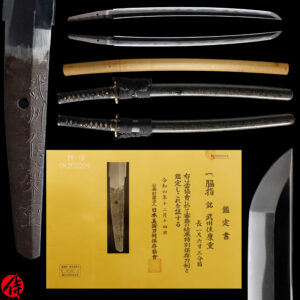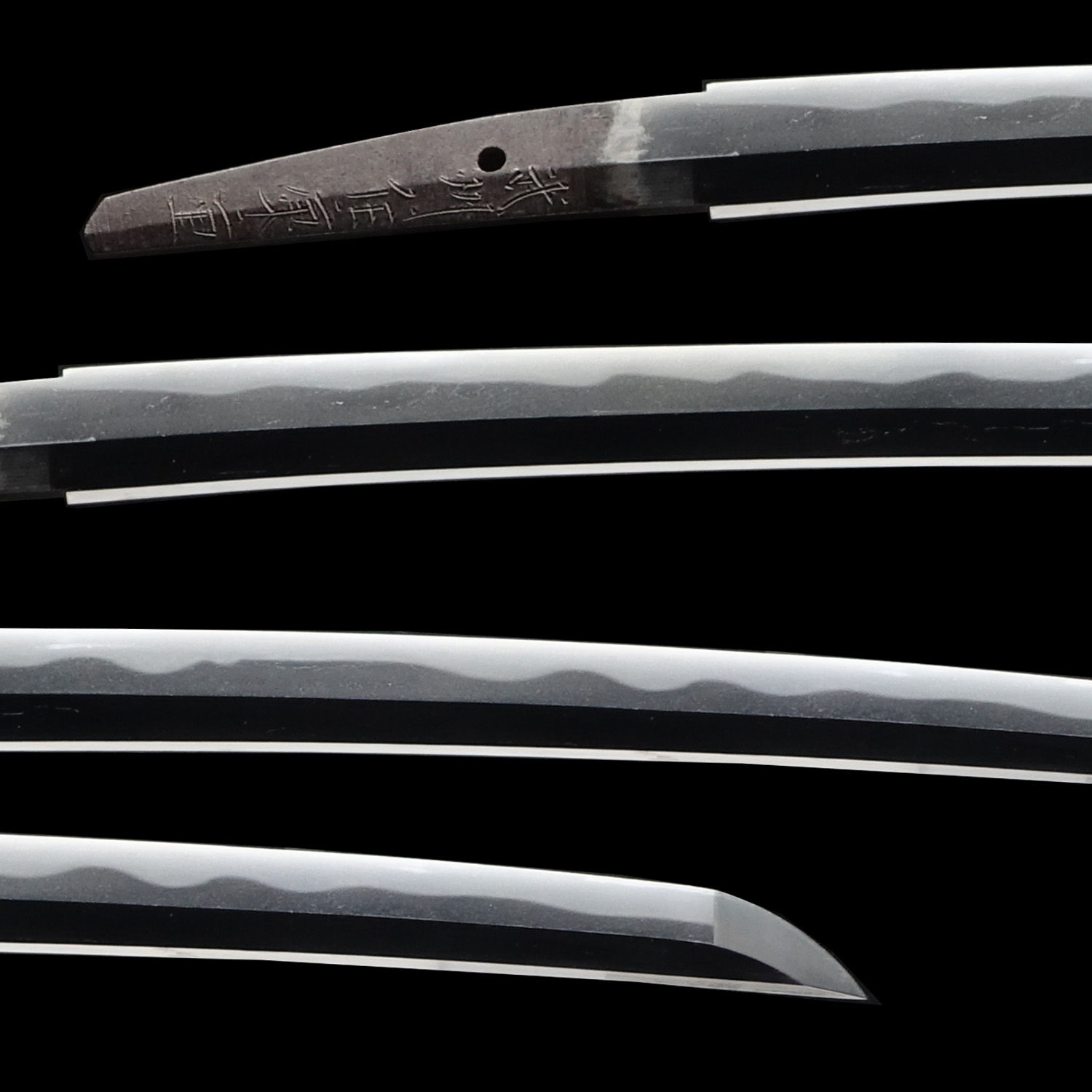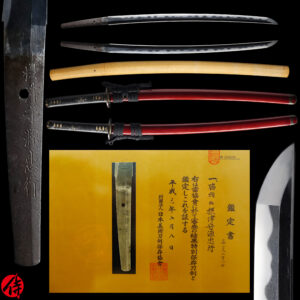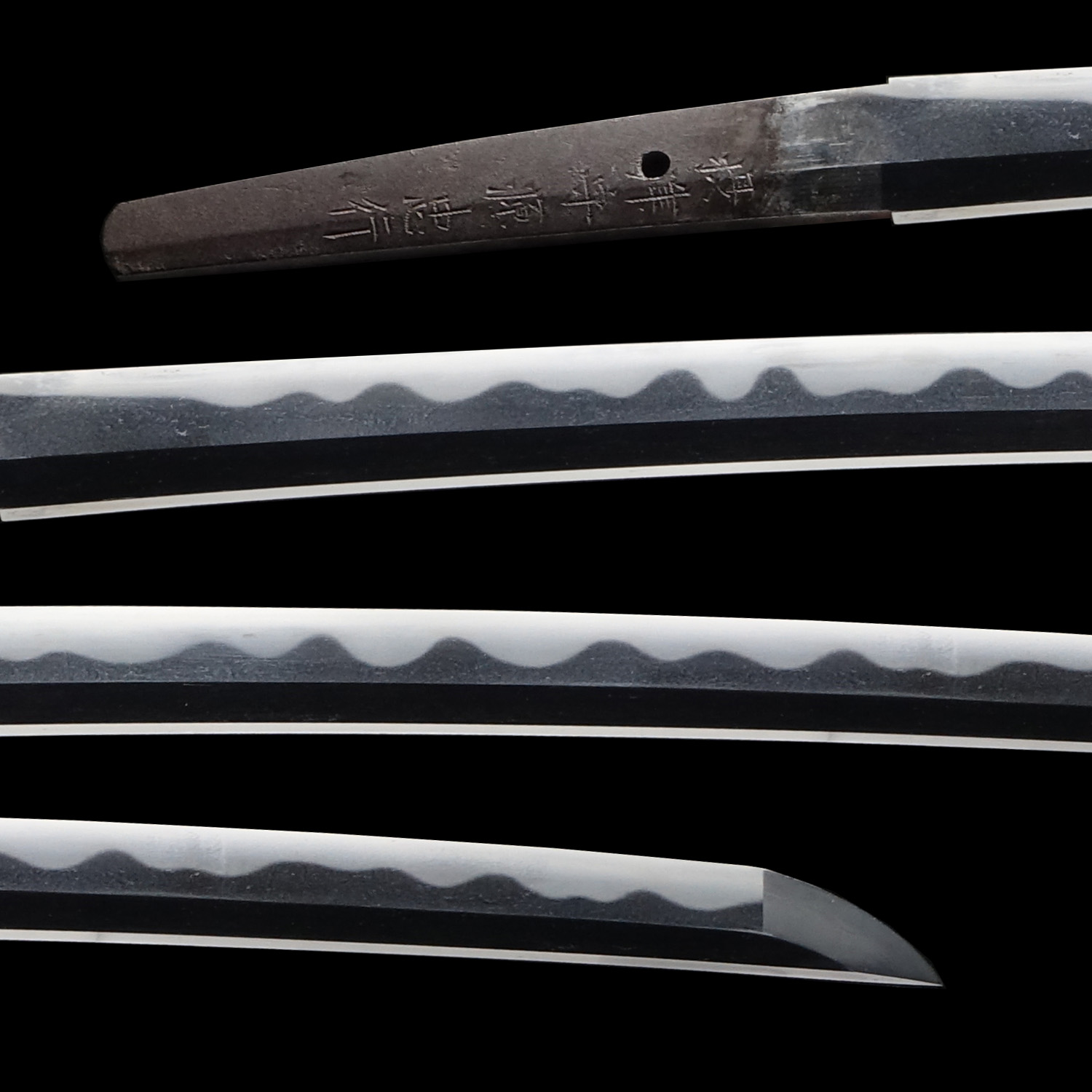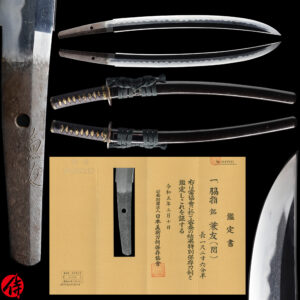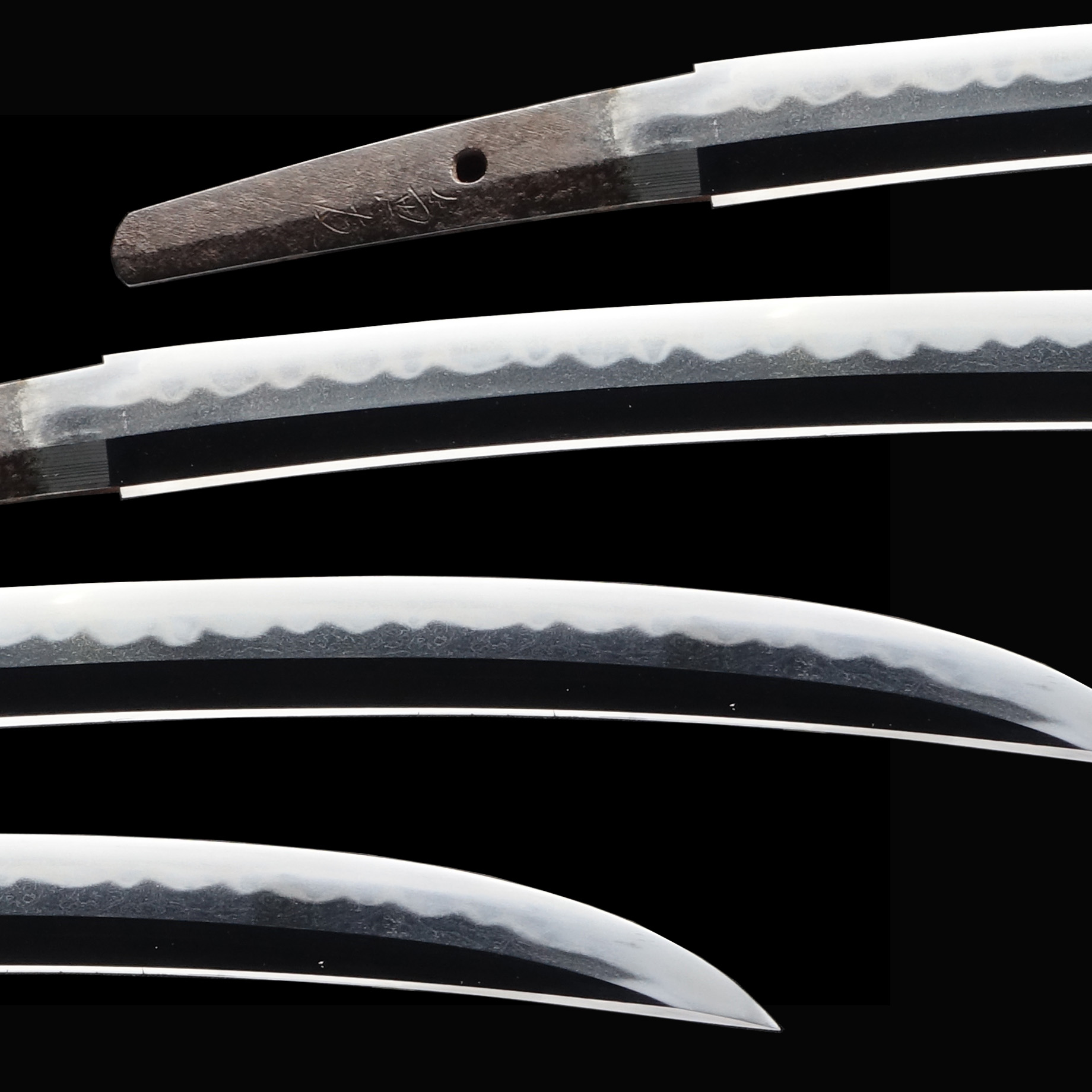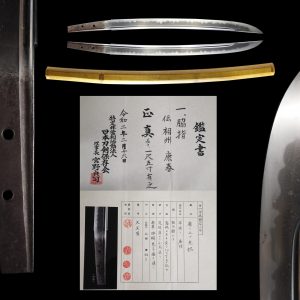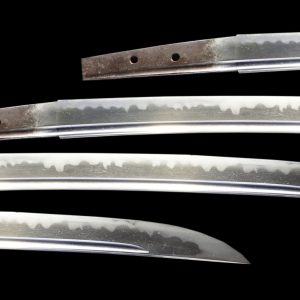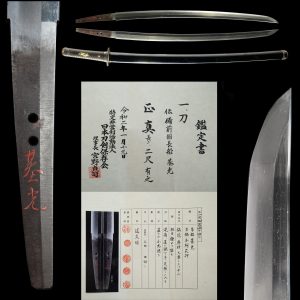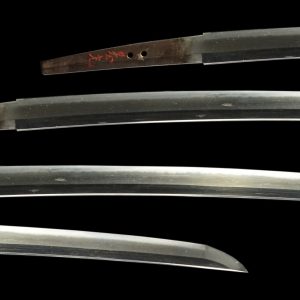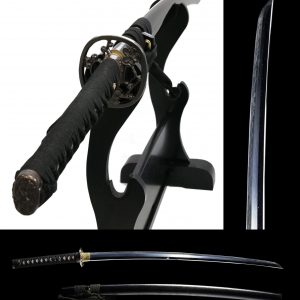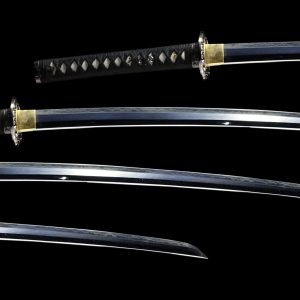Antique Japanese Sword Wakizashi attributed to Mihara with NBTHK Tokubetsu Kicho Token and Tosogu Certificate
【Description】
Summary
This blade is attributed to Mihara, a prestigious school in Bingo province (Today’s Hiroshima prefecture). According to recent studies, it is general knowledge that Mihara school was founded by Kokubunji Sukekuni (国分寺助国) in the late Kamakura period (Late13th century-Early 14th century). Two of the most prominent figures in this school are Mihara Masaie (三原正家) and his son, Masahiro (正広).
Mihara school is divided into three categories in Japanese sword terminology depending on the period. When the blade is older than the Nanbokucho era(the 1300s), it is called Ko-Mihara (Old Mihara). And it is called Mihara for those who forged in the early-Mid Muromachi period. Finally, Sue-Mihara(Late Mihara) is used for the late Muromachi period. Based on the NBTHK appraisal of this blade, it was approximately forged during the late early-mid Muromachi period (Late 14th- Early 15th century).
In Bingo province, many lands were owned by politically powerful temples of the Yamato region (today’s Nara prefecture) from ancient times. And many Samurai formed military groups to protect those lands, being hired by temples. And quite a few swordsmiths moved from the Yamato region to the Bingo region to forge blades for those Samurai.
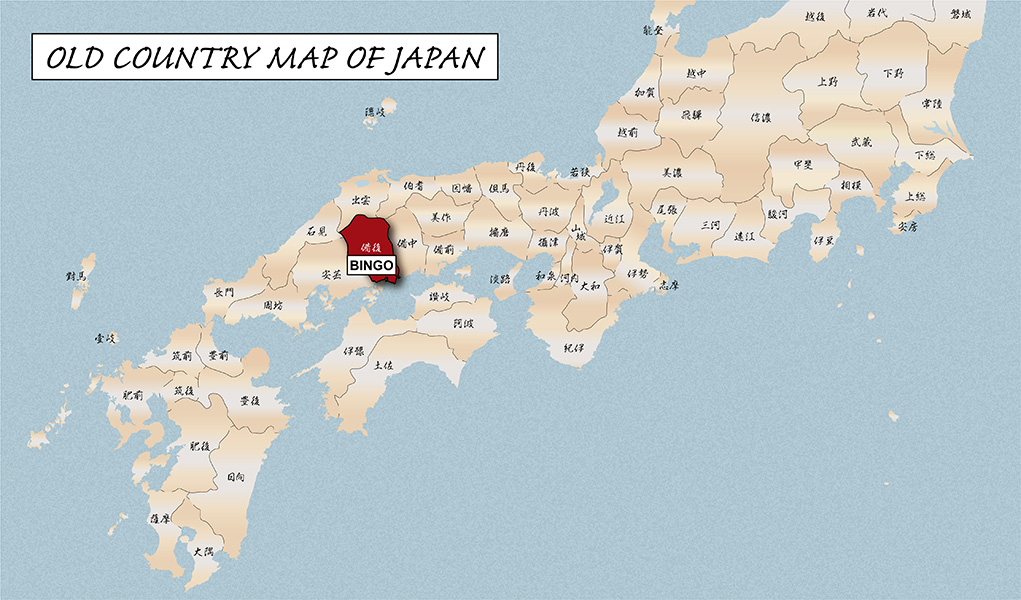
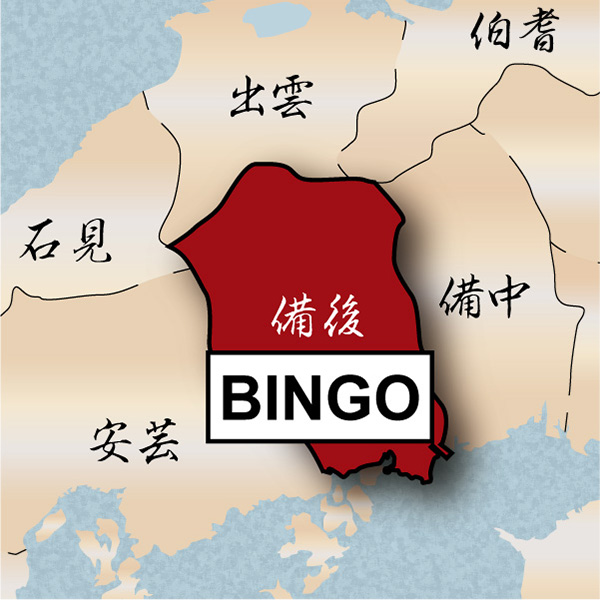
It is said that the swordsmiths in Yamato region strongly influenced how swords were forged in the Bingo province because of the history above. The blades forged by Mihara school had distinctive characteristics of Yamato DEN, one of the five Japanese sword traditions (Gokaden).
Bingo is located near the Chugoku Mountains, where iron sands, one of the essential materials for making Japanese swords, were abundant. This geological location contributed to the Mihara swordsmiths forging high-quality refined blades. We presume Bingo was quite active in sword-forging from ancient times.
The swords forged in Yamato DEN tradition are famous for their beautiful Jigane, steel surface, and straight tempering line(Suguha). This blade has a beautiful Jigane with a Suguha tempering line, which shows an outstanding characteristic of the Yamato DEN sword.
You can see interesting Kissaki (tip of the blade) called Shobu Zukuri (菖蒲造り). There is no Yokote on this blade. Yokote is the borderline between the tip and cutting edge. We are confident you will appreciate the elegant look of this blade. The Makie lacquer painting applied on the Saya of this blade will also enhances the appreciation of this blade.
【 Blade】
Cutting Edge Length(Nagasa):57.7 cm( 22.7 inches)
Curvature(Sori):1.6 cm( 0.63 inches)

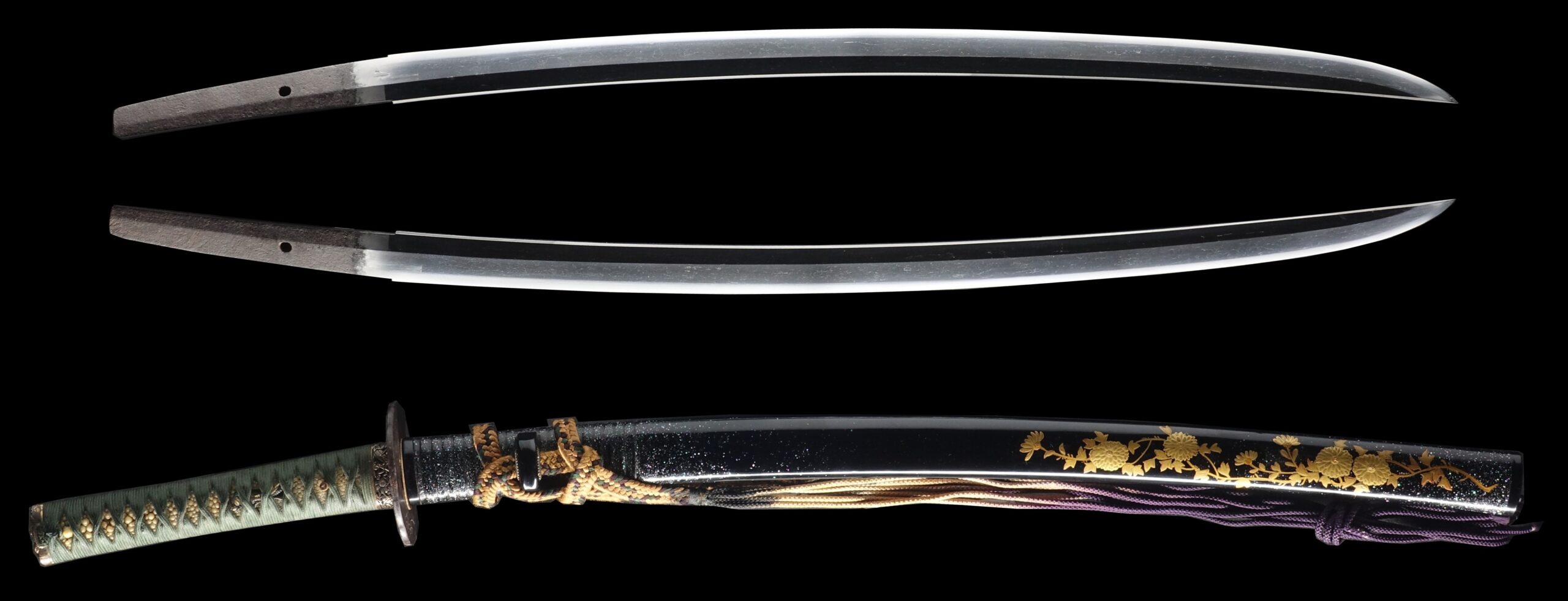
Hamon:
The crystalline structure which forms along the cutting edge of a blade as a result of the hardening process
Jimon(Jihada):
visible steel surface pattern created by folding and hammering during forging process

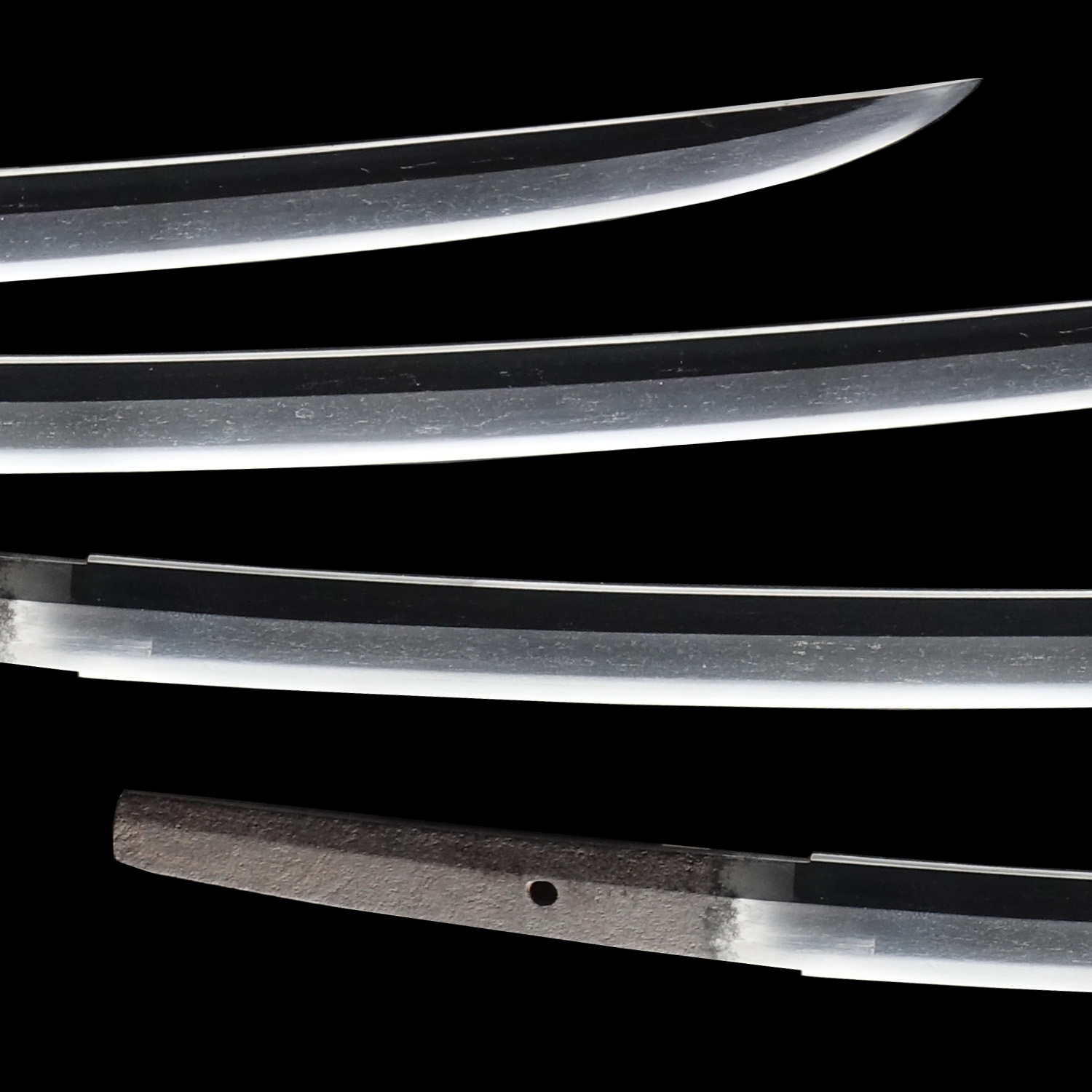


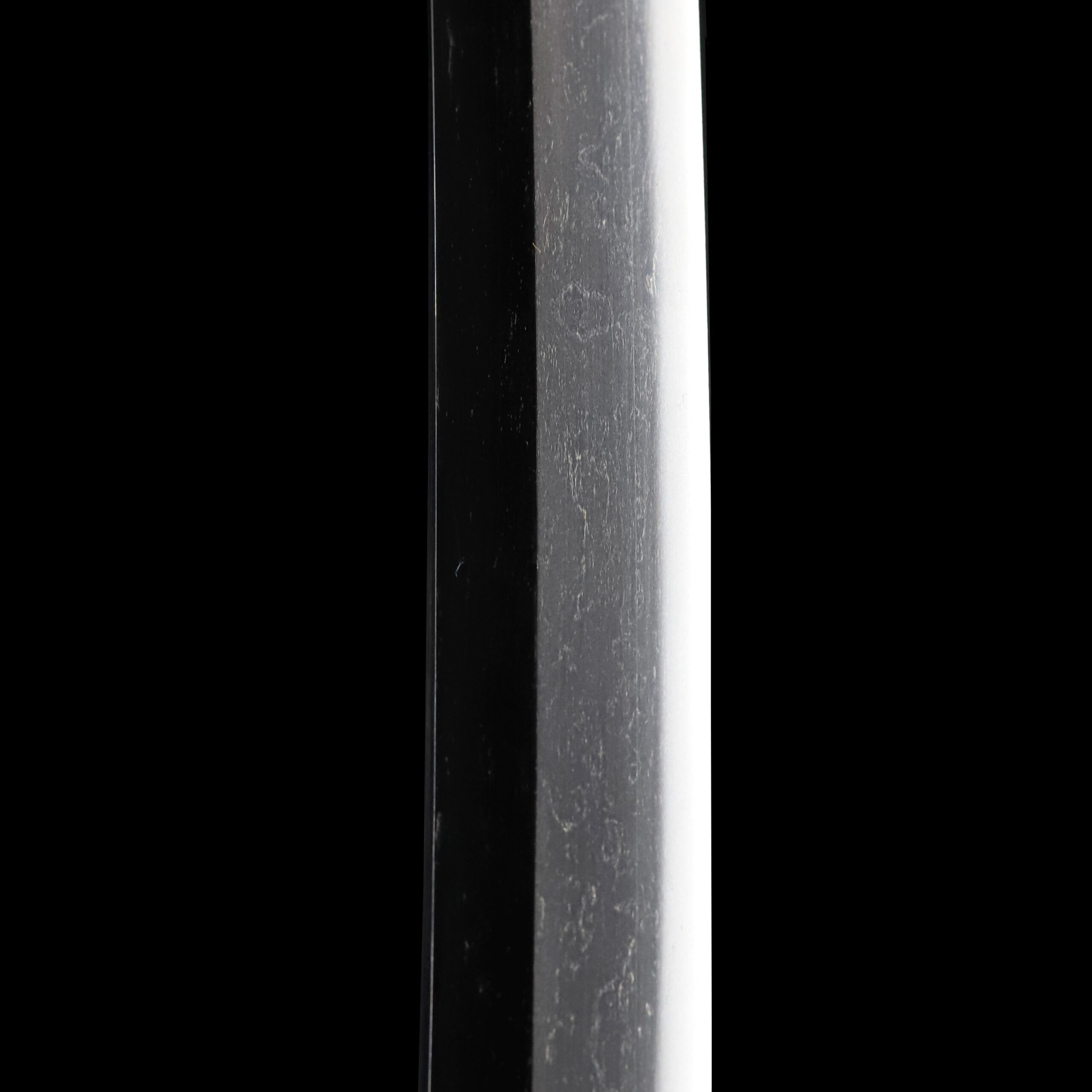
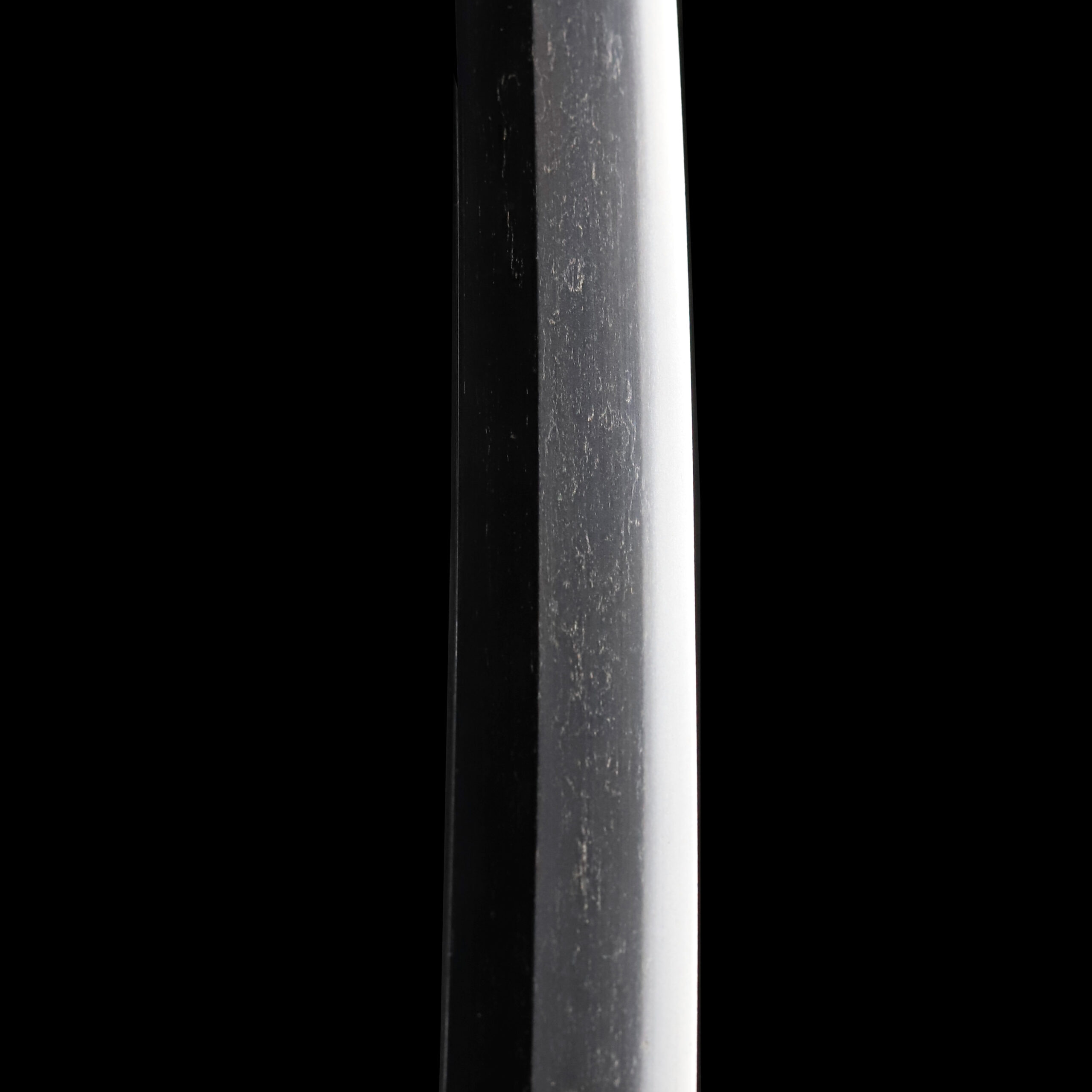
Nakago:Nakago is the tang of the Japanese sword.
Japanese swordsmiths left the black rust on the tang because it prevents red rust while the tang is in its handle. And the discoloration of the tang was created over time, and it is a great indicator for a Japanese sword specialist to estimate when the sword was forged.

Koshirae: Koshirae is the mounting of the Japanese sword. There are several parts that consist of Koshirae such as Saya(Scabbard), Tsuka(Handle), Tsuba(Handguard).
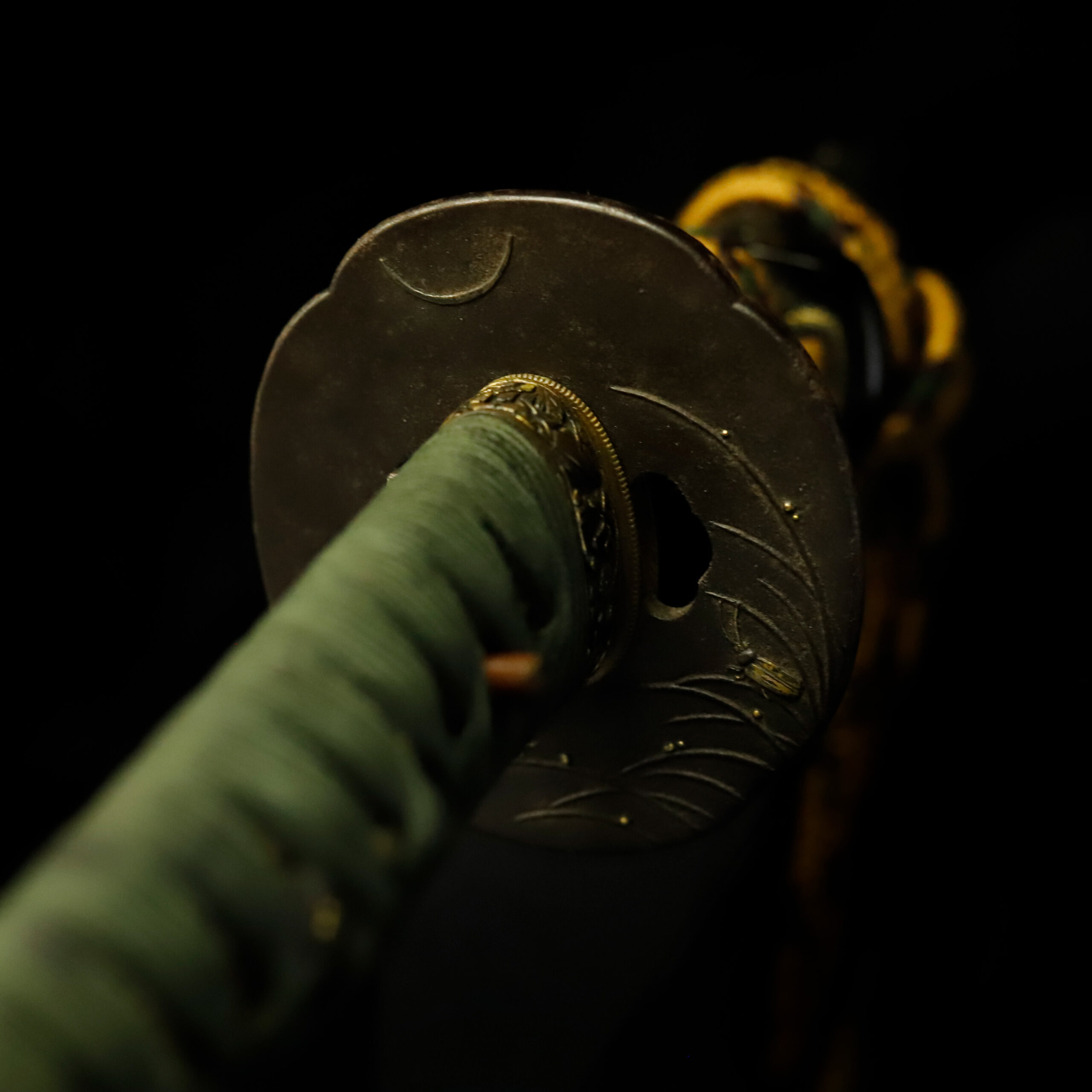
Fuchi-Kashira:A pair of matching sword fittings that cover the upper and bottom parts of its sword hilt.
Sword mountings of this Uchigatana Koshirae (打刀拵) have the same theme. Each of them is decorated with autumn motifs, such as plants and insects. Especially on this Fuchi Kashira, various motifs are engraved.
There is an engraved inscription on the side of the Fuchi part. It is written as follows: 美濃住 光仲 (Mino-Ju, Mitsunaka). Mino (美濃) is today’s Gifu prefecture. If this inscription is to be believed, this Fuchi Kashira is probably a work of Mino-Bori (美濃彫), that developed in this area. Mitsunaka is mentioned among the masters of Mino-Bori; however, it is challenging to say for sure whether this work is by him. Many of their metalworks express motifs such as autumn grasses, crickets, mantises, chrysanthemums, and lotuses. Even if the maker cannot be determined, it could be said that this Fuchi Kashira inherits the characteristics of this carving style.
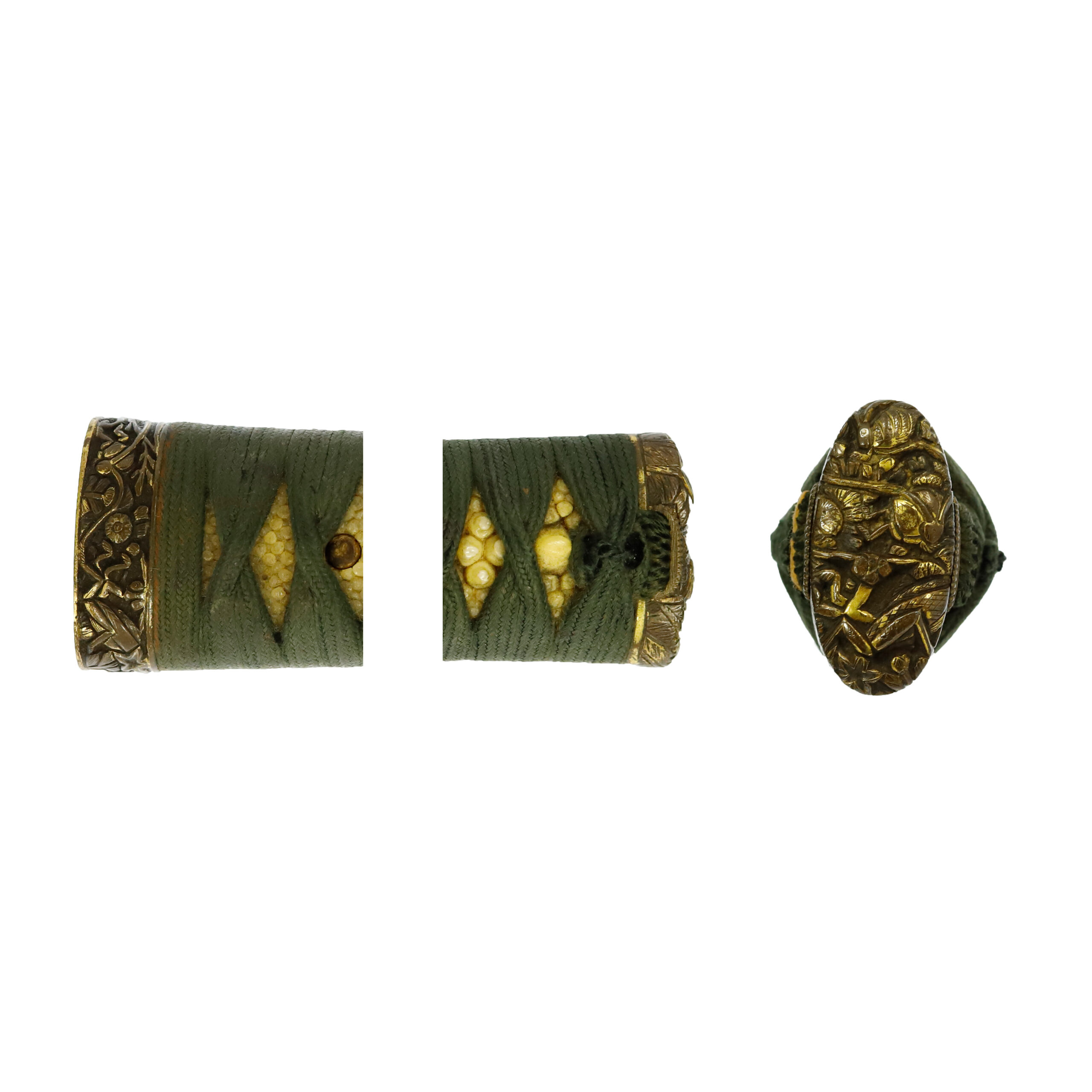

Tsuka and Menuki:Tsuka is the handle of the Japanese sword and Menuki is its decoration.
Seeing from the gaps of the Tsukamaki thread, we could see that two autumn insects are designed on each side of this handle. Since this design is related to the Fuchi Kashira and Tsuba (about the Tsuba, please check the following description), these insects look as if they have jumped out of there.


Tsuba and Habaki:Tsuba is the handguard for the Japanese Sword and Habaki is the equipment to make the blade not touch its scabbard inside. It prevents the blade from getting rusty and chipped.
Yotsu-Mokkou-shaped iron Tsuba that has Kozuka and Kougai holes. You would find the figures of two crickets riding on thin leaves and watching the crescent moon floating in the night sky. The moon is a classic design that symbolizes autumn and has been treated as an object of worship since ancient times. Some people considered them the symbol of authority. The moon pattern has various shapes depending on the waxing and waning of the moon: full moon, half-moon, crescent, or hazy moon. There is also the idea: as the moon changes its shape depending on its fullness, it represents growth and development.

Kozuka:Kozuka is a small knife stored in Kozuka Hitsu(groove of the sheath of the Japanese sword).
A Kogatana (小刀, small knife) is stored in the Kozuka. Same as other sword mountings, an autumn insect is engraved on it. This Kozuka is made from the Shakudou, and its surface is decorated with the Ajiro (網代) pattern. It is the design in which rows of oblique right and left rectangles are alternately combined. The intersection angle is not a right angle, and the rectangle sometimes becomes a parallelogram. It is used for dyeing and weaving tint patterns and is also seen in bamboo works. The Ajiro is a wickerwork trap, fishing gear made of bamboo instead of a net. Therefore, this design represents a large catch. Also, some people believed it would exorcise evil spirits.
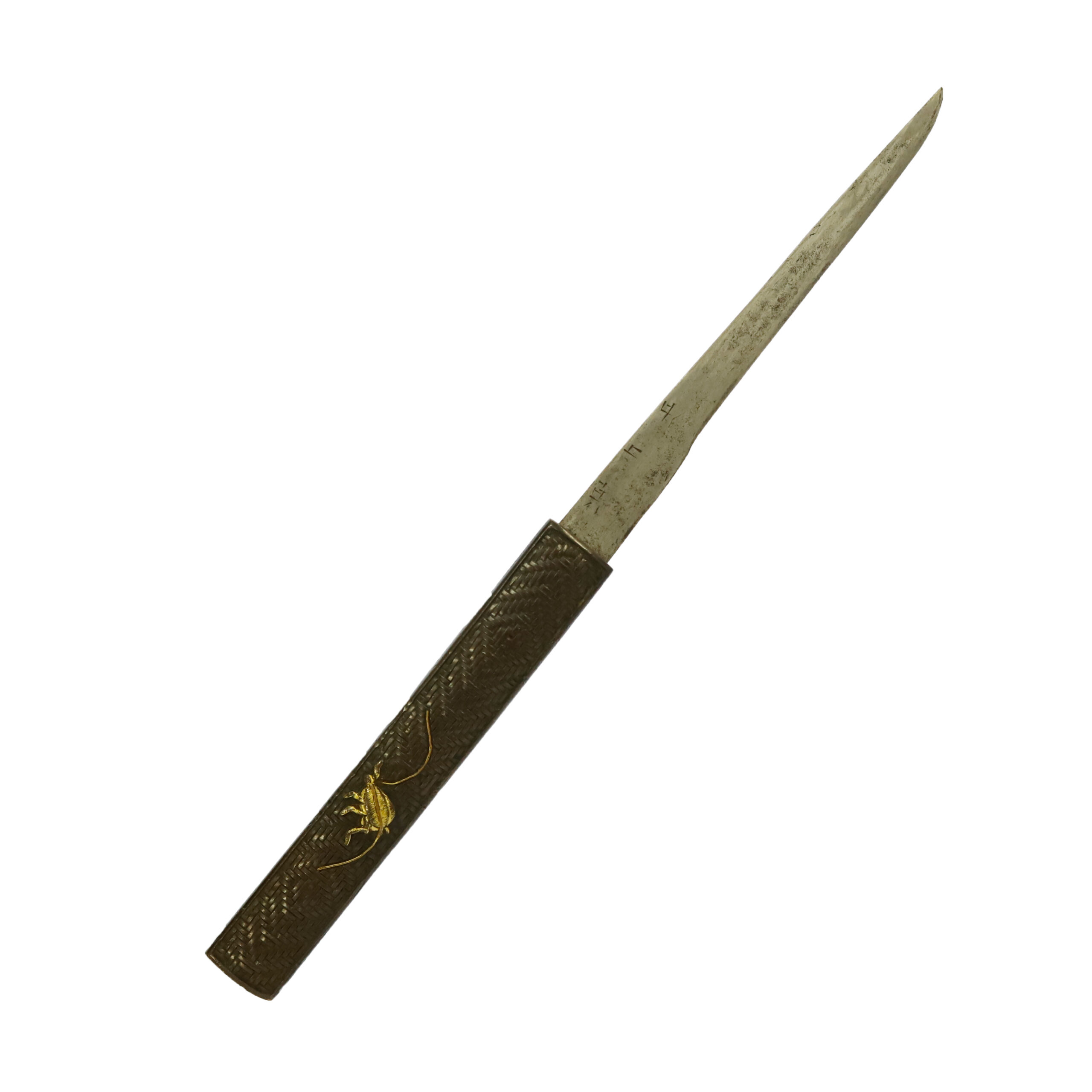

Saya: Saya is the scabbard for the Japanese sword.
This scabbard has an elegant and ornamental appearance. Chrysanthemums are gracefully depicted by the Makie (蒔絵) technique on the black lacquered scabbard. The Makie is a typical Japanese lacquer art technique developed uniquely in Japan for about 1200 years. Firstly, it needs to draw a picture with lacquer on the surface with a thin brush. Next, sprinkle the gold powder from above to show the pattern before the lacquer hardens. This technique makes a gorgeous look to works, as seen here.
A long time ago, chrysanthemums were used as a medicine for obtaining a long life in the continent, and this flower was brought to Japan with this thought in the Nara period (648-781). The chrysanthemum symbolizes fall, and people have greatly appreciated it since ancient times. The chrysanthemum has been likened to the sun as its petals form radially. That is why this flower pattern is treated as the symbol of perpetual youth and longevity or good health.

Authentication Paper:NBTHK Hozon Tokubetsu Kicho Certificate for the blade and sword mountings
NBTHK, also known as Nihon Bijutsu Touken Hozon Kyokai (the Society for the Preservation of the Japan Art Sword), is one of the oldest Japanese sword appraising organizations in modern-day Japan. They authenticated the blade on October 25th in the 44th year of Showa (1969) and the sword mounting on July 9th in the 47th year of the Showa (1972). They appraised it as Tokubetsu Kicho Token/Tosogu, an old form of the certificate. The purchaser will receive these original certificates as well. We can also translate what is written into English and make a PDF file for your record if you request.


Registration Number : Kanagawa 47960
The Board of Education in Kanagawa prefecture issued a registration paper for this sword . It is called Jyu Token Rui Torokusho(銃刀剣類登録証). Bunkacho(The Agency for Cultural Affairs) acknowledges a Japanese sword with this paper as a work of art.
The sword needs to be traditionally hand-forged and made of Tamahagane carbon steel to be registered in the system. With this paper, its owner in Japan can legally own an authentic Japanese sword. Based on this registration number, we will apply for its export permit.
This paper will need to be returned to the board of education when the sword is being shipped abroad, but you can receive a copy of it. An English translation of this registration paper is available on request.
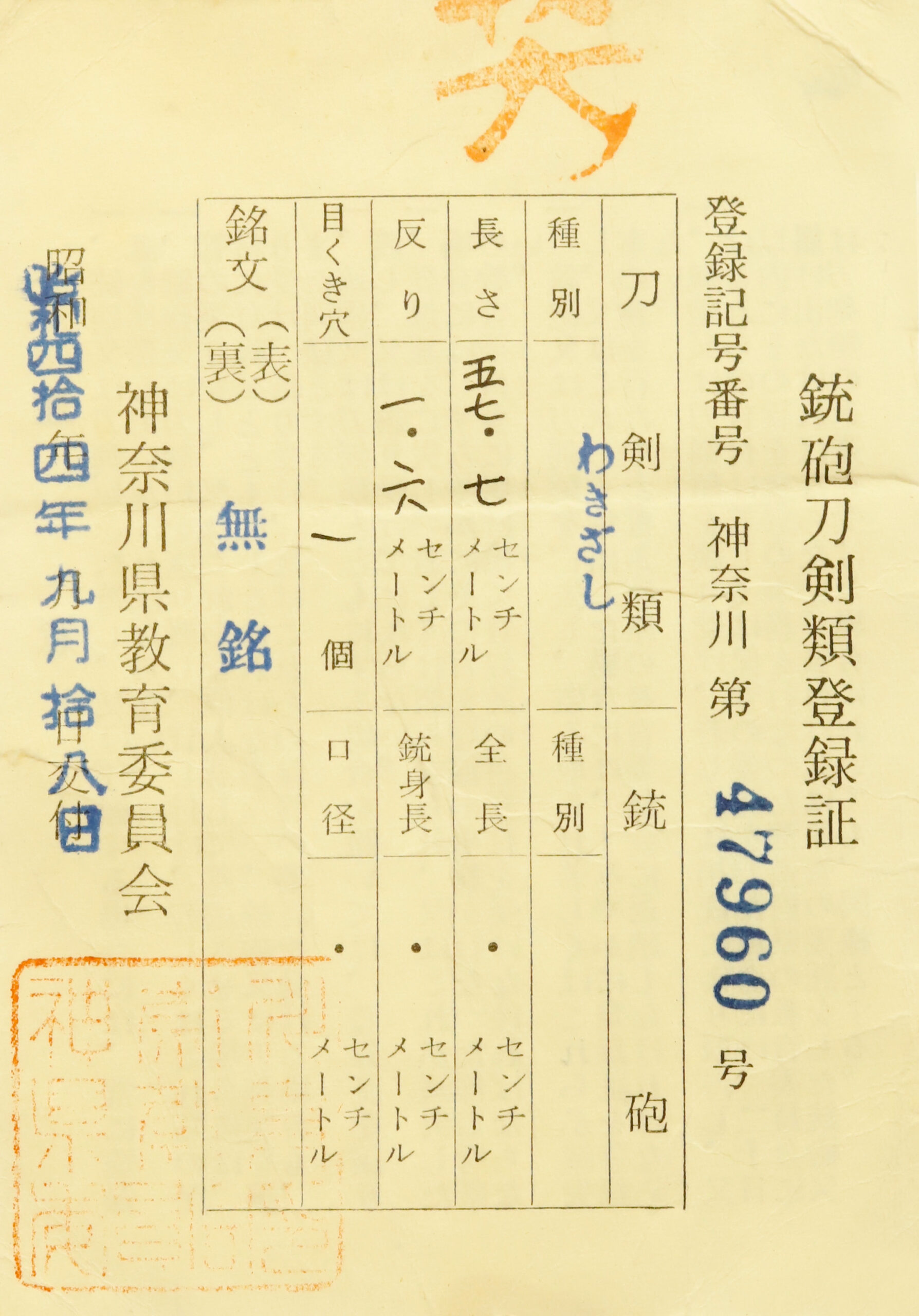
Antique Sword Stand: We purchased this Wakizashi and sword stand from the previous owner. They have been together for many years. To show respect to them, we sell this Wakizashi and stand as a set. You cannot purchase them separately.
| Width | Depth | Hight | Weight |
| 44.0 cm (approx.) | 18.5 cm (approx.) | 37.0 cm (approx.) | 954 g (approx.) |
About the design, this sword stand has a refined look. This sword stand is entirely painted with black lacquer, and each motif is elegantly expressed using the gold Makie (蒔絵) technique. The Makie is a typical Japanese lacquer art technique developed uniquely in Japan for about 1200 years. Firstly, it needs to draw a picture with lacquer on the surface with a thin brush. Next, sprinkle the gold powder from above to show the pattern before the lacquer hardens. This technique makes a gorgeous and elegant look to works, as seen on this sword stand.
You could find the figures of Kiji (雉, pheasant) resting their wings on a rock. From the shape of its crest, the one in the foreground is probably the male, and the one in the back is the female. Since ancient times, this bird has often appeared in Waka (和歌, Japanese poetry) poems that think about families, so it is said that pheasants symbolize family love and marital love. The pheasant was designated as the national bird of Japan in 1947. A beautiful bird endemic to Japan, it is familiar in folk tales and nursery rhymes. Its male is considered the symbol of bravery, and the female symbolizes maternal love.
The rocks at the foot of the pheasant and the plants depicted in the background are partly decorated with the Raden (螺鈿), giving the work a brilliance and splendor like jewelry. The Raden is a kind of decorative technique that is often used for traditional craftworks. It uses the pearl part of seashells and puts it into the engraved surface of lacquer or wood. Thanks to its iridescent luster, it gives a luxurious look to works, the same as the Makie.
This sword stand is a masterpiece that expresses the figure of a bird, which symbolizes Japan, using traditional Japanese craftsmanship. We hope you enjoy its beauty by exhibiting your sword(s) on this stand.
*As this product is an antique, there are small scratches and dents on the wood. Please check each photo and ensure its condition.
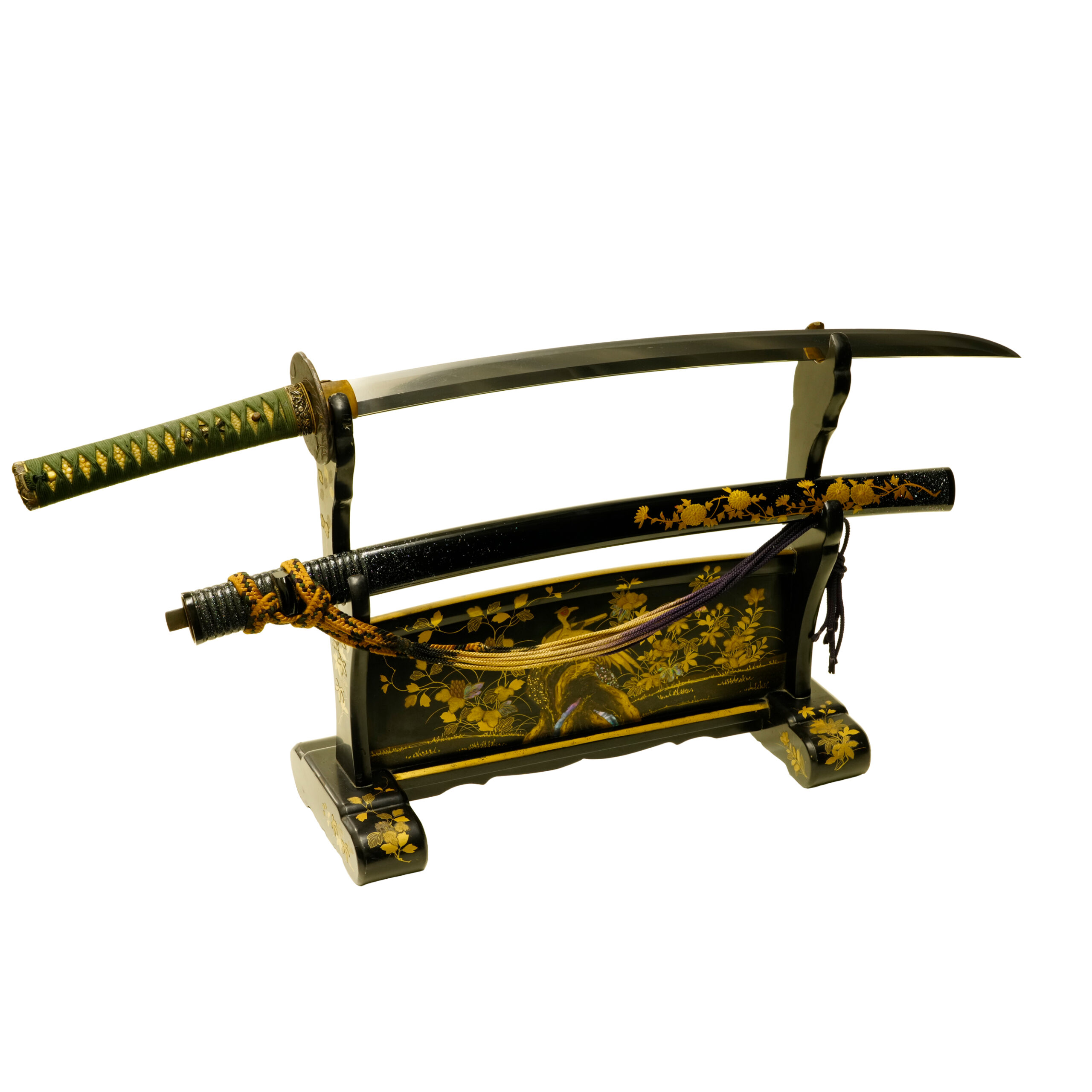


—————————————————————–
【About us】
Samurai Museum is located in Tokyo, Japan, exhibiting antique artifacts related to the Samurai history. Samurai Museum Shop is the place for those who are interested in Japanese culture and craftsmanship. We deal with antique Samurai swords/armor, traditional crafts made in Japan and so on.
【Japanese Sword& Export Process】
The Japanese swords we deal with are hand-forged edged swords made in Japan. It was made from the traditional carbon steel called TAMAHAGANE(玉鋼). Samurai Museum is familiar with the proper legal procedure for an antique/ authentic Japanese sword to be exported from Japan. We have sent more than 700 Japanese swords for the past few years (~2024) to amazing owners who appreciate its historical value.
Each Japanese sword is registered under the Agency for Cultural Affairs and the Board of Education in Japan. They issue a registration paper for each Japanese sword for its owner in Japan to legally possess it. The Japanese sword with its registration paper means it was traditionally hand-forged in Japan.
To legally export the sword from Japan to other countries, we will have to apply for its permit to the Agency for Cultural Affairs(Bunkacho) and return the original registration paper to the Board of Education. It normally takes around 2-4 weeks to receive this permit after submitting required documents. And we would like you to expect at least 1-1.5 months for your order to arrive at your given address after you ordered. For more detailed info, please click here.
It is allowed for residents in Japan to own authentic Japanese swords without a special license as long as they come with registration papers. Please feel free to contact us if you are a resident of Japan, whether temporarily or permanently. We will also assist you when you leave Japan and need to obtain the export permit.
【Payment Method】
We accept payment through Stripe (Credit card), PayPal, Apple Pay or ChromePay, all of which are secure payment methods. Also, you don’t need to make an account on Stripe for the checkout. If you prefer other payment method, please contact us. After confirming your payment, we will apply for an export permit. You may either pay in JPY, USD, AUD, CAD,EUR CHF or GBP. The price is set in Japanese Yen. Prices in other currencies are automatically calculated based on the latest exchange rate.

* If the amount is above 1 million JPY, Stripe or wire transfer will be the only options for payment.
【Shipping】
We have shipped authentic Japanese swords to the USA, UK, Canada, Mexico, Germany, France, Hong Kong and Australia. If you don’t live in these countries and like to order, please contact us first before making a purchase. We offer Free International Shipping as long as we can send antique Japanese swords by EMS.
We normally ship by EMS(Express Mail Service) provided by Japan Post. We will send you a tracking number for your order as soon as we hand it to the post office. We will put 100 % insurance on the shipping document without any extra charge. Based on the total amount, there might be a duty tax or other fee for you to pay, depending on the countries. We use package cushioning to protect the item and put it in a PVC pipe, which is one of the most secure packages because of its durability.
It will normally takes 5-14 days for the item to arrive at your given address after we dispatch it. Time of delivery is estimated as accurately as possible by the carrier but does not take into account any delays beyond our control such as by inclement weather, post office holiday seasons.
* If you live in Australia and like to purchase an authentic Japanese sword, please click here to know the detail.

【Review】
Here is one of the reviews we received from a customer who purchased an authentic Japanese sword from us. For more reviews, please click here.
“My experience overall with the whole process was wonderful. I had many questions about the history and process to purchase these treasures. All my questions were answered very timely and complete. The staff is very knowledgeable and very well versed if any questions do arise.”
【How to make sure the condition】
Please keep in mind that what you are going to purchase is an antique item. We uploaded high resolution photos for you to check its condition thoroughly. If you like to see more photos with different angles, please feel free to contact us. We will be happy to send them to you so that you can make informed decision. It is essential for us to know that you are happy with your choice of a sword. and we are prepared to use the best of our ability to serve you.
【How To Contact Us】
Please contact us through email, Facebook Messenger or Live Chat if you have any questions. You can find each icon on the right side of the website. Please click one of them to reach us. We will reply to you within 1-2 business days.
【The Art of Nihonto (Japanese Sword)】
Samurai’s history is a profound, eloquent legacy of ancient Japanese warriors in which millions of people worldwide are being fascinated. If you like to find out the art of Nihonto, please click here.
【A Guide to Japanese Sword Maintenance】
After acquiring an genuine Japanese sword, it is also important to know how to take good care of it. Here is the special video for you. Mr. Paul Martin, Japanese sword expert, shows you how to give proper maintenance to your sword. By mastering how to clean the Japanese sword, its aesthetic beauty will last forever.
When you purchase a Japanese sword from us, you can get a Free Japanese sword maintenance kit. It comes with four tools(Choji Oil, Uchiko Whetstone Powder, Peg remover, Oil Applicator). By watching the video instruction above , you can enjoy learning how to maintain your Japanese sword while appreciating it. If you have any difficulty assembling the sword or cleaning the blade, you can feel free to contact us.


MORE ANTIQUE JAPANESE SWORD FOR SALE
SWORDS WITHOUT CERTIFICATES FOR SALE
LEARN JAPANESE SWORD TERMINOLOGY
Thank you for reading all the information on the page. If you have any difficulty choosing the right Japanese sword for you, we will be more than happy to help you find the one that speaks to you the most. Please feel free to contact us.



